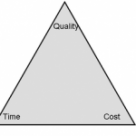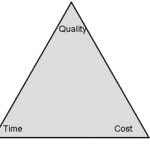Is the iron triangle outdated?
Posted by on Dec 3, 2021 in PMChat Bloggers, Uncategorized | Comments Off

 If you are into project management you are probably familiar with the good old iron triangle which is how project management is traditionally measuring the success of a project. It states that projects must be delivered to the triple constraints of time, cost and quality. The iron triangle reflects the view that our role as project managers is to deliver the project to the customer’s specification (quality) within the agreed time and budgetary constraints, which to some extent is true. But it sometimes happens that we deliver a beautifully crafted product, system or device which meets all of the stated requirements, but which somehow ends up not being used the way it was intended, if at all. For the project team (or supplier) this could be seen as a successful delivery as the product met the customer’s stated requirements, but for the customer it is a failure because it didn’t produce any benefits. It did not add any value. The problem may be that the project manager is not taking a broad enough view of what ‘quality’ constitutes, and is not measuring how the project will add value to the client and to society in the short and long term.
If you are into project management you are probably familiar with the good old iron triangle which is how project management is traditionally measuring the success of a project. It states that projects must be delivered to the triple constraints of time, cost and quality. The iron triangle reflects the view that our role as project managers is to deliver the project to the customer’s specification (quality) within the agreed time and budgetary constraints, which to some extent is true. But it sometimes happens that we deliver a beautifully crafted product, system or device which meets all of the stated requirements, but which somehow ends up not being used the way it was intended, if at all. For the project team (or supplier) this could be seen as a successful delivery as the product met the customer’s stated requirements, but for the customer it is a failure because it didn’t produce any benefits. It did not add any value. The problem may be that the project manager is not taking a broad enough view of what ‘quality’ constitutes, and is not measuring how the project will add value to the client and to society in the short and long term.
View article:
Is the iron triangle outdated?



